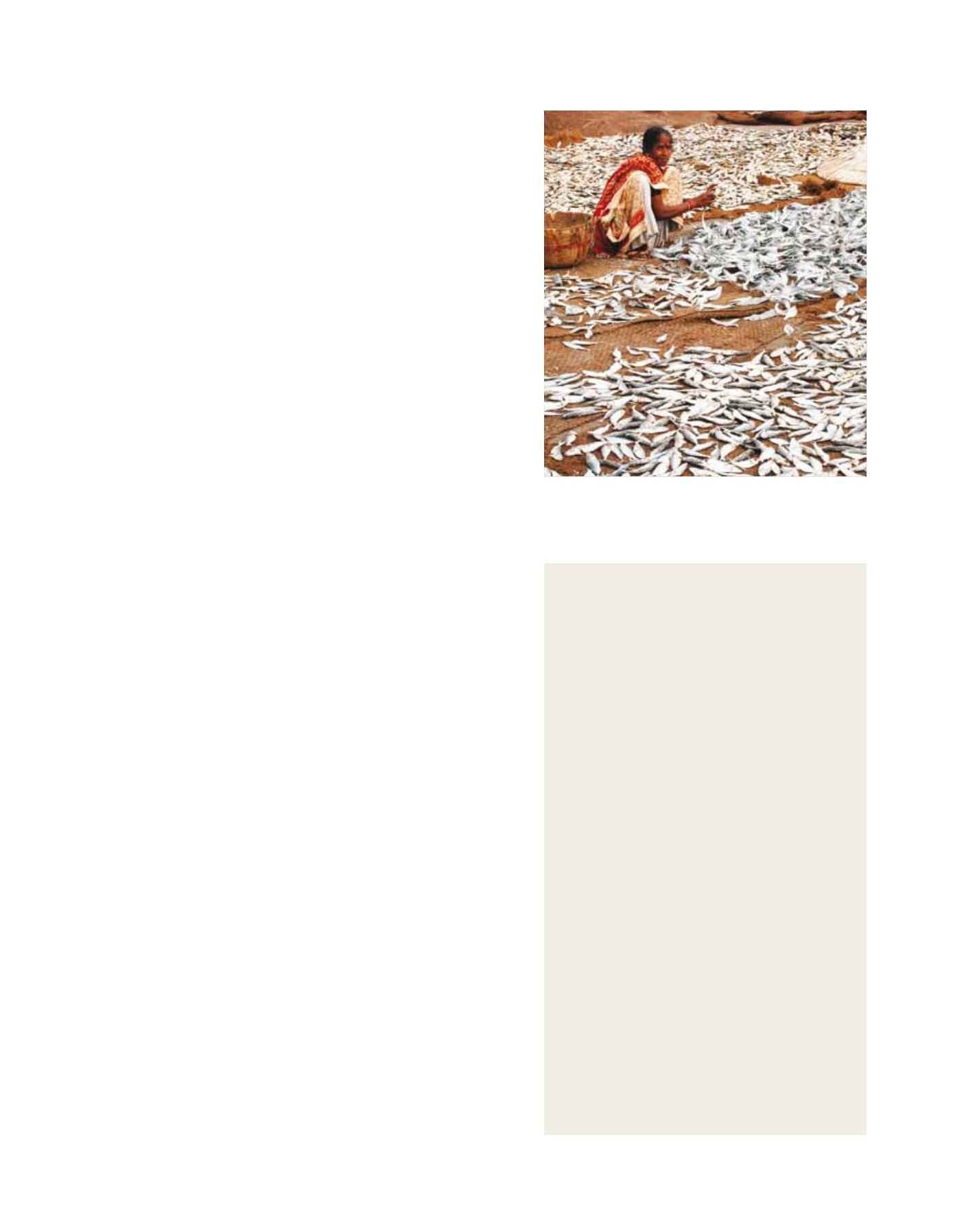

[
] 68
A
griculture
sary to first strengthen the existing management measures and their
successful implementation.
The fisheries sector is facing the familiar problems of overfish-
ing, pollution and habitat degradation. Reducing fishing mortality
in the majority of fisheries, which are currently fully exploited
or overexploited, is one of the principal means of reducing the
impacts of climate change. Reduction of fishing effort will (i)
maximize sustainable yields, (ii) help adaptation of fish stocks and
marine ecosystems to climate impacts, and (iii) reduce greenhouse
gas emission by fishing boats. In this regards, it is also necessary
to seriously consider adapting the FAO’s Code of Conduct for
Responsible Fisheries.
Monitoring, Control and Surveillance (MCS) mechanisms need
to be improved to observe and manage the fish stocks and fishing
efforts. MCS should also include collection of climatic and oceano-
graphic data. Long-term environmental and ecological monitoring
programmes are important, since data cannot be collected retro-
spectively. In India, spatial marine fish catch and effort data are
available for the last four decades but a synergy between climatic
and oceanographic data and fisheries data is lacking. Projections
on climate change impact on fish populations need to be developed
as the first step for future analytical and empirical models, and
for planning better management adaptations. In most of the other
countries in the region, the data collections mechanisms also need
to be further strengthened to draw conclusions on the impact of
climate change on fisheries.
Towards a methodology for adapting to climate change in the
BOBLME region
4
Taking preventive measures
– Coastal planning should take into
account the impacts of climate change, especially sea level rise, SST,
prolonged droughts, severe rainfall, cyclones and storm surges.
Integrated coastal zone management is essential for coastal zone
planning, management, monitoring and evaluation. It requires close
coordination with government agencies and communities. Coastal
communities should be prepared to combat climate change through
disaster preparedness activities.
Increased awareness on the impacts of climate change
– Countries
should prepare specific policy documents on the implications of climate
change for fisheries sector. These documents should take into account
all relevant social, economic and environmental policies and actions
including education, training and public awareness related to climate
change. Effort is also required to raise awareness of the impact, vulner-
ability, adaptation and mitigation related to climate change among all
stakeholders so that they can become watchful and perceptive.
Research requirements
– All these procedures should be guided
by a cooperative research programme. That is a programme not
just specifically for climate change but more on how to move from
the present state to a state of readiness. This should also involve a
two-way interaction with the fishers to keep them informed of the
developments at all times.
Presently, options for adaptation to climate change in the
BOBLME region are limited but do exist. In the present context,
the primary challenge before the fisheries sector is to ensure food
and nutritional security, improve livelihood and economic output,
and ensure ecosystem integrity. These objectives call for identifying
and addressing the concerns arising out of climate change; evolving
adaptive mechanisms and implementing action across all stakehold-
ers at national, regional and international levels.
Case study: Sembasipalli village, Pulicat, Tamil Nadu
Sembasipalli village is located 50km to the north of
Chennai city and lies on margin of Pulicat Lake, one of the
largest brackish water lakes in India. The village has 250
households, with a total population of 920.
Sembasipalli has 262 active fishers and a fleet of 86
motorized boats. Fishing and fishing-related activities and
rearing of livestock form the major economic activity in the
village. Most fishing is carried out with set bag nets in the
estuarine waters during monsoon and gill nets and purse-
seines throughout the year in the lake and the adjacent sea.
The major species harvested include: Indian mackerel, oil and
lesser sardines, prawns and crabs.
Mullets and Lactarius spp. formed the dominant fishery
in the late eighties, but have gradually declined and are
now rarely found in the lake fishery. This is due primarily to:
reduced rainfall, siltation of the lake mouth and consequent
decreased inflows and less water exchange, increase in
temperature and reduction in water level due to heavy
intake of water by the neighbouring thermal power plant at
Ennore. The villagers feel that besides the impacts of the
thermal power plant, the repeated delay in the onset of
monsoon in the area is affecting the spawning of fish and
thereby reduction in fish abundance.
Due to the decline in fish catches from the lake and
coastal waters, the fishers are venturing into the deeper
waters. Ten years ago the fishers were fishing in depths of
12-15 fathoms, but now they are fishing in 25-35 fathoms,
an increased distance of 5-8km from the traditional
fishing grounds. As compared to previous years, the Indian
mackerels and oil sardine are now dominating the landings.
The fishers of Sembasipalli seem to be more aware of
the phenomenon of changing climate. From the general
observations, the villagers have reported occurrences of
erratic winds after the December 2004 Asian Tsunami,
increased SST and sea level. The villagers feel that their
day-to-day life is affected by the changing climate and they
would like to learn more about the science behind the
climate change phenomenon and adaptation of climate
change through awareness programmes.
Increased landings of low value species such as oil sardines
require interventions in post-harvest methodologies, especially for
fisher women in the region
Image: S Jayaraj
















